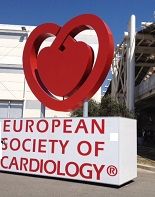Article
ESC Congress 2016: What's the Take-Away?
Author(s):
The European Society of Cardiology's ESC Congress 2016 in Rome, Italy was huge, hot, and full of drama. Will any of the thousands of research reports delivered change practice?

The European Society of Cardiology’s ESC Congress 2016 in Rome, Italy was huge. It drew more than 33,000 physicians and other professionals involved in cardiology-- attendees from 140 countries.
It had drama. The event was bracketed by tragedy in the earthquake that happened 100 miles away just before the congress began, and a by message of hope and healing delivered in person by His Holiness Pope Francis on the meeting’s last day.
Despite some logistical problems--such as an overtaxed transit system and taxi shortage that made getting to and from the venue an often maddening and expensive task, 90 degree heat and no air conditioning, and sporadic wifi blackouts--the meeting delivered six fully packed days of new research results, discussion and debate.
ESC Congress 2016 will likely mean lasting memories for many who attended. But will any of the thousands of research papers and clinical trial results presented change medical practice?
Several studies presented challenge the wisdom of some current practices endorsed by ESC guidelines, those of the American Heart Association/American College of Cardiology, or both. Some study findings support those guidelines but assert that the practices in question might not be as helpful as thought.
The debates are likely to continue but at least physicians appeared to agree on what the most interesting studies to come out of the meeting have been.
Among them:
A study called NorStent showed that drug-eluting stents were less beneficial compared to bare metal stents than researchers had expected.
The people who got the drug devices showed no significant reduction in mortality.
Does that mean that bare metal is just as good?
It does not, said Deepak Bhatt, MD, MPH, Executive Director of Interventional Cardiovascular Programs at Brigham and Women’s Hospital Heart & Vascular Center in Boston, MA and a professor of medicine at Harvard Medical School.
“Reduction of death is a lot to ask,” Bhatt said, commenting on the study. That is particularly true since the second-generation metal stents to which the drug stents were compared are generally more safe and efficacious than the ones that preceded them.
The most useful finding of the study in terms of practice is that in countries where price is a deterrent to getting the more expensive drug stents, the bare metal devices are a good alternative.
Otherwise, the drug-eluting stents “Absolutely should be the first choice,” Bhat said.
Another study seen as controversial, billed as the DANISH study, found that there is no reduction in mortality with appropriate patients who were implanted with cardiac defibrillator devices that can cardiovert an abnormal heart rhythm.
The patients in that study had non-ischemic systolic heart failure. At follow-up of more than five years (67.6 months) patients who got the devices had about the same mortality rate (21.6%) as controls (23.4%).
But there were fewer sudden deaths from cardiac causes in the group that got the devices (4.3% of device patients vs. 8.2% of controls). Age mattered in the results, the researchers found and patients younger than 68 also had a significant reduction in death from any cause.
Current AHA guidelines recommend the devices for all patients with symptomatic systolic heart failure, not just patients with non-ischemic disease.
In a study on the cardiovascular benefits of continuous positive airway pressure (CPAP) machines, researchers concluded that while they made patients with sleep apnea happier and more energetic, they showed no signs of reducing serious adverse events.
Specifically, 17.0% of patients in a group using the machines had a serious cardiac event, vs. 15.4% of patients who had sleep apnea but did not get a CPAP.
The researchers called the results “disappointing.”
But in reviewing the study in an interview at the meeting, former ACC president Kim Williams, MD, said the researchers put the wrong spin on the study.
Hearing that the study was being interpreted as discouraging the use of CPAPS, Williams said “That confirms my worst fears,” in that such a conclusion was not justified by the findings.
The key element likely overlooked, Williams said, was that the study excluded the patients who were most likely to have a cardiac event without their CPAP, such as patients with known heart disease.

The researchers should have stressed that their findings related only to relatively healthy patients, he said..
“For my patients CPAPs have been a lifesaver,” Williams said.
Controversy also arose with what Bhat called a “potentially practice-changing” study on lowering blood pressure in patients with coronary artery disease (CAD) and hypertension.
At issue is how low blood pressure can go in these patients without compromising blood flow to the heart.
The controversy at the meeting came not from the new study, based on a registry called CLARIFY, but on the 2015 US study to which it was compared, one called SPRINT.
The CLARIFY study found that the danger point for these patients was 120mm Hg.
The findings support the existence of a J-curve phenomenon, where the initial lowering of BP is beneficial but further lowering is harmful,” said CLARIFY principal investigator Philippe Steg, MD, PhD.”
In a debate at the meeting, Sverre Kjeldsen, MD, PhD of Oslo, Norway said the SPRINT results were flawed because of the way the subjects’ BP readings were taken.
That meant less stress for the patients, and lower readings because patients tend to be more agitated when a physician or other medical professional is taking the reading. Kjeldsen said the readings taken in these more relaxed patients were likely 10 to 20 mm Hg lower than they would be had a white-coated professional been in the room.
That would mean that the readings in SPRINT should not be interpreted as being comparable to the readings in CLARIFY.
Commenting on the study during the meeting, Bryan Williams, MD, of London, UK agreed, saying of SPRINT that “there is a question on whether those measurements were accurate.”
He added that in any case, lowering BP further than the current recommendation of 140 mm Hg was unrealistic in that most patients with hypertension have been unable to lower their BP to that goal.
The CLARIFY investigators found that after a median follow-up of five years, a systolic BP of 140 mmHg or more and a diastolic BP of 80 mmHg or more were each associated with an increased risk of cardiovascular events.
Systolic BP less than 120 mmHg was also associated with increased risk for the primary outcome (adjusted HR 1.56 [95% confidence interval (CI) 1.36—1.81]) and all secondary outcomes except stroke. Likewise, diastolic BP less than 70 mmHg was associated with an increase in the risk of the primary outcome (adjusted HR 1.41 [1.24–1.61] for diastolic BP 60–69 mmHg and 2.01 [1.50–2.70] for less than 60 mmHg) and in all secondary outcomes except stroke.
“We found that systolic blood pressure less than 120 mmHg was associated with a 56% greater risk of the composite primary outcome of cardiovascular death, myocardial infarction, or stroke,” said Steg, principal investigator in the study. “Diastolic blood pressure between 60 and 69 mmHg was associated with a 41% increased risk of the primary outcome, with risk rising to two-fold when diastolic blood pressure fell below 60 mmHg.”
He added: “This large study of hypertensive CAD patients from routine clinical practice found that systolic BP less than 120 mmHg and diastolic BP less than 70 mmHg are each associated with adverse cardiovascular outcomes, including mortality. The findings support the existence of a J-curve phenomenon, where the initial lowering of BP is beneficial but further lowering is harmful.”
More detail on all the studies and the studies themselves are available on the ESC Congress website.
Further reading: MDMag.com’s coverage of ESC Congress 2016 is on our conference page.
“





